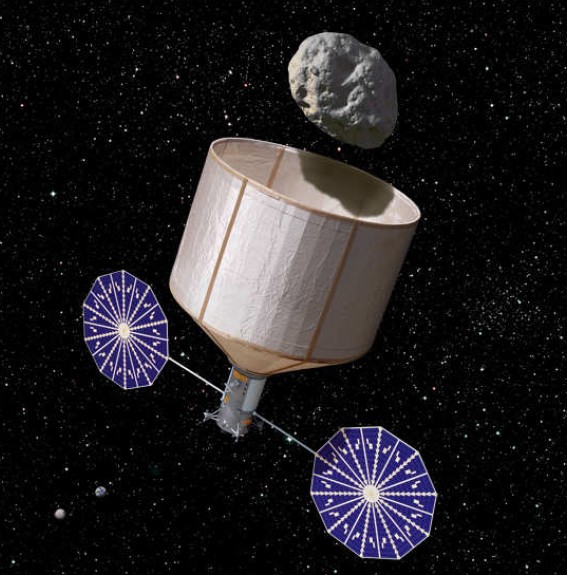NASA through the latter part of the 20th century developed two programs, one manned, the other robotic. The former initially was driven by a political agenda in a race with the Soviet Union to get a human to the Moon and back. The latter was dedicated to building a space-based Earth support infrastructure and doing pure science in the form of discovery and exploration of the Solar System.
After the successful landings on the Moon NASA went on to develop the Space Shuttle, a space truck that became the equivalent of a gas guzzler eating up much of the organization’s annual budget. NASA’s old rivalry with the Soviets and its successor Russia’s Roscosmos, both beset by severe budget cuts, by necessity turned into a collective venture focused on building a permanent orbiting space station, the International Space Station (ISS) that orbits the Earth today. Deep Space human missions that were envisioned by both countries in the latter part of the 20th century ended up on the back burner with the entire program focused on activities in support of the ISS.
Other countries soon joined the partnership making their contributions to the ISS and its completion. It remains the principal human space destination, that is, until recently when China established its own human space flight program and announced its objective to duplicate what the United States and Russia have done in low-Earth orbit. China also has announced its plans to send their own human missions to the Moon. What China is doing is not original but it at least has an objective for its human space program.
That really cannot be said about NASA which seems to have lost its way with human space flight and is feeling cash constrained to the point that it is cutting back on essential space infastructure missions. The same could be said about Roscosmos. There seems to be no firm direction and funding driving NASA beyond the ISS. There certainly is a lot of talk about ideas for human space flight but these missions go beyond the end date of the current administration and could be rewritten by the next President, and the next after that, who may have entirely different priorities. And that’s the problem in a nut shell. NASA’s direction remains politically driven subject to a dysfunctional budgetary process and the American debt “crisis.”
So what has NASA got planned for human space flight over the next two decades? Three objectives have been announced by this current administration. They are:
- To build and launch a new heavy-lift space launch system (SLS) with an Orion crew capsule to re-visit the “lunar area” possibly with a follow up plan to create a permanent station at a Lagrange Point 60,000 kilometers from the far side of the Moon. To what purpose? To test human endurance beyond low-Earth orbit and to study Near Earth objects and the Moon itself.
- To send a mission to an asteroid in 2025. Which one? Right now NASA is considering a rock called 1999 A010 Near Earth Object. This mission would take at least six months and would expose its human crew to cosmic radiation in Deep Space as well as take them beyond reach of any possible rescue should something go wrong.
- To go to Mars by the mid 2030s. A mission of this type would be multi-year. The challenges and potential hazards of such an enterprise cannot be completely understood right now. But take mission number two and add a danger multiplier.
Can NASA achieve any of these with current budgets? No!
These are objectives largely unfunded. For them to happen will require the agency to either see dramatic increases in U.S. federal money or find partners, both nations and private enterprise. Potential partners already exist with Japan’s JAXA, Europe’s ESA, a growing number of other nations launching space agencies and programs, and three private companies SpaceX, Boeing and Sierra Nevada, all currently under contract to NASA to resupply the ISS, let alone other companies that are looking to space to turn a profit. Even China could abandon its go-it-alone effort and become a participant. With the objectives no longer politically mandated, NASA could be a leader among equals in a global enterprise, a partnership of nations and companies reaching for the stars.
This week NASA announced that it had been “mulling over a plan” since last April to launch a robotic spacecraft with an objective to “grab an asteroid” and place it in lunar orbit at a cost of $2.6 billion. The mission timetable would be sometime in the 2020s and the thinking is that such an activity would be more attractive than a human mission to an asteroid and would certainly be less risky.
What is a suitable asteroid target?
First NASA would have to identify suitable Near Earth asteroids (NEAs). The ideal size would be around 500,000 kilograms (1,200,000 pounds). The type of asteroid most desired would be volatile rich, that is, one that was carbonaceous and contained water in the form of ice.
How would this be accomplished?
If the mission were solely robotic, the devices would first capture the NEA, then attach solar electric propulsion systems to it and move it into position in space where the Moon’s gravity would capture it just enough to place it into permanent lunar orbit.
Would there be a need for human presence to accomplish the goal?
The mission to capture and move the NEA would not require a human mission. But the exploitation of the resource would suggest a human presence at some future date.
What would we gain from such a mission?
Some would argue that by capturing NEAs we will be able to demonstrate an ability to save Earth from a future collision with one.
Certainly the raw materials in a NEA could be used by a permanent occupied space station at a Lagrange Point behind the Moon. The regolith could serve to shield the human habitat from cosmic rays. The ice could serve many needs including providing oxygen for breathing, hydrogen for fuel, and liquid water for consumption. The minerals in the NEA could be refined and used to expand the existing station. Minerals extracted could even be transported back to Earth. Such an expedition could be just the thing to stimulate international cooperation in human and robotic space missions with collective minds focused on developing the technology necessary to capture, transport, and exploit NEAs. And the public relations value, according to a Caltech study states:
The excitement of changing the orbit and harnessing the resources of a celestial object for space exploration is obvious. A mission like this even decoupled from human exploration would engage a whole new generation of space interested persons, and coupled to the goal of enabling sending humans further than ever before in space it would inspire even more public interest. Beyond the excitement is the wide range of educational goals that would accompany this venture: knowledge of Earth’s celestial environment, the engineering and mathematics of asteroid orbit modification, the science of solar system resources and the exploration into the solar system. Apollo was based on a cold-war rationale and ever since an over-arching geo-political rationale has been lacking from space ventures. Retrieving an asteroid for human exploration would provide a new purpose for global achievement and inspiration.
A final word!
Nowhere in any U.S. government document on space policy is there any mention of this type of mission. So is this wistful fantasy or something to seriously consider versus the “pie-in-the-sky” unfunded plans of the current administration? One thing for sure, NASA needs a purpose and direction for its human flight program beyond the ISS.









<>
Well, it’s not so sure that the US or the world needs NASA itself. NASA has evolved into an insatiable black-hole money pit. Its management seems indifferent to cost/benefit analysis of various mission proposals. NASA has transformed into just another bloated and mediocre government institution that mostly serves the interests of the politicians, bureaucracy, and contractors. It maintains the classical bureaucratic studied contempt for the public interest.
Ask yourself why SpaceX systems, a private for profit company, can put a pound into orbit at about 1/10 the cost of NASA systems. The public would be better served if NASA was completely abolished and a start-from-scratch new agency formed to address space activities. The new agency might be named something like: Cybernetics Development Agency. Its initial focus would be on development of strong AI. Even if no space missions implementing the emergent technology were ever launched, at least the taxpayers would get some returns from enhanced production here on Earth.
If we can’t master space with AI robotics, we sure as the devil can’t master it with hominid mush meat. I’m guessing NASA will never attempt a sealed “manned space station” in the middle of a desert on the Earth’s surface, because it knows its likely failure would kill all funds for a boondoggle L2 manned space station. NASA is an embarrassingly costly quasi-solution in search of a worthy problem.
This is not the first time you have expressed your considerable disappointment with NASA. I, too, believe that NASA in its present form should go away and be replaced by two programs. One, an award program with government and private enterprise in partnership, focused on human space activity. The second, a space science program focused on robotic exploration of our Solar System and beyond. The first one could offer awards from both public and private funds to firsts. For example, the first to create a completely self-sustaining enclosed living environment here on Earth….the prize $10 million. The first to establish a human occupied permanent station at a Lagrange Point……the prize $100 million. That to me would foster healthy competition and create the kind of technology we need to do anything else in space with humans aboard. The second program would be funded by government, research institutions, private endowments focused on technology, etc. Anything else done in space would be left to private enterprise. If a corporation wants to mine asteroids, as long as safeguards are in place to ensure that no exobiology is compromised, the company is welcome to proceed. This is not the purview of government.
I also strongly believe that space is not a national enterprise but one that should be based on international goal setting. The Cold War is over and does not need to be re-energized in a new space war between an emerging space program such as China’s and established space programs from the U.S. and Russia.